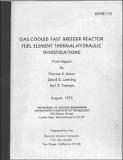| dc.contributor.author | Eaton, Thomas Eldon | en_US |
| dc.contributor.author | Lanning, David D. | en_US |
| dc.contributor.author | Todreas, Neil E. | en_US |
| dc.contributor.other | Massachusetts Institute of Technology. Department of Nuclear Engineering | en_US |
| dc.contributor.other | General Atomic Company | en_US |
| dc.date.accessioned | 2014-09-16T23:35:27Z | |
| dc.date.available | 2014-09-16T23:35:27Z | |
| dc.date.issued | 1975 | en_US |
| dc.identifier.uri | http://hdl.handle.net/1721.1/89725 | |
| dc.description | "August 1975." | en_US |
| dc.description | "Prepared for the General Atomic Company P.O. Box 81608 San Diego, California 92138." | en_US |
| dc.description | Also issued as an Sc. D. thesis by the first author and supervised by the second and third author, MIT Dept. of Nuclear Engineering, 1975. -- Technical report has the following sub-title: Final report | en_US |
| dc.description | Includes bibliographical references (pages 295-301) | en_US |
| dc.description | Final report; August 1975 | en_US |
| dc.description.abstract | Experimental and analytical work was performed to determine the influence of rod surface roughening on the thermal-hydraulic behavior of rod array type, nuclear fuel elements. Experimental data was obtained using a grid-spaced, 37-rod hexagonal test section with both a smooth and a rough rod array. The rods were 0.331 inch (8.41 mm) diameter with a pitch/diameter of 1.30. The roughened surface used trapezoidal ribs 6-mils (0.15 mm) high with a rib pitch/height of 12. Velocity profiles taken at the flow exit plane indicated that when comparing the rough array results with the smooth, the gap velocities were lower, the peak-to-average velocities were higher: and the peripheral subchannel velocities were higher. Axial static pressure profiles. were used to determine rod array friction factors and grid loss coefficients. The friction factor results were in agreement with predictions using tube data. | en_US |
| dc.description.abstract | The friction factor multipliers were strongly Reynolds number dependent and grid losses were apparently 10% higher in the rough rod array. Detailed pressure profiles were taken in the axial vicinity of the grid spacers. Coolant mixing data using a salt solution tracer was obtained for smooth and rough arrays. Flow scattering at the spacers was responsible for most of the smooth array tracer dispersion. In the rough array, turbulent interchange was considerably higher. The grid-spaced, rough array, dimensionless mixing coefficient was estimated to be 0.C20 + 0.005. Flow scattering at the grids prevented the determination of geometry and Reynolds number effects, as well as, the smooth array mixing coefficient. By neglecting coolant mixing and radial pressure gradients, an equation was developed to determine the flow rate in the subchannels of a nuclear fuel element with roughened surfaces and gas-cooling. | en_US |
| dc.description.abstract | Relative subchannel flow rates were influenced by flow regime, fuel element geometry, fuel rod surface roughening, Reynolds number and coolant property variations. Two simple models were discussed which estimate the "equivalent friction factor" in partially roughened flow passages. Computational results obtained using the RUFHYD code showed that fuel element thermal-hydraulics are influenced by both rod array design parameters and operating conditions. Calculational results included axial subchannel flow distributions, optimum subchannel design estimates, and peripheral subchannel flow sensitivities to changes in rod-to-wall gap. | en_US |
| dc.format.extent | 514 pages | en_US |
| dc.publisher | Cambridge, Mass. : Dept. of Nuclear Engineering, Massachusetts Institute of Technology, [1975] | en_US |
| dc.relation.ispartofseries | MITNE ; no. 172 | en_US |
| dc.subject.lcc | TK9008.M41 N96 no.172 | en_US |
| dc.title | Gas-cooled fast breeder reactor fuel element thermal-hydraulic investigations : final report | en_US |
| dc.type | Technical Report | en_US |
| dc.identifier.oclc | 857059174 | en_US |
